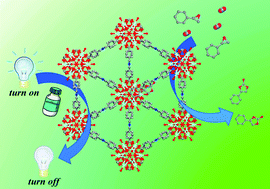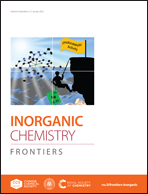An yttrium-organic framework based on a hexagonal prism second building unit for luminescent sensing of antibiotics and highly effective CO2 fixation†
Abstract
A 3D hybrid microporous highly connected yttrium-organic framework (Y-TCPP) based on 2,3,5,6-tetrakis(4-carboxyphenyl)pyrazine (H4TCPP) was favourably built via solvothermal reaction. H4TCPP can be regarded as a 4-connected rectangular geometry node, and the 12-connected Y9 cluster can be simplified as a hexagonal prism second building unit (SBU). The Y9 SBUs further interconnect with the TCPP4− ligand, resulting in a 3D framework with shp topology. Y-TCPP not only exhibits outstanding chemical stability in the organic phase but also possesses permanent porosity with a BET surface area of 1125 m2 g−1. Y-TCPP exhibits excellent fluorescence properties and can be used to detect a small amount of furacillin in aqueous solutions. Moreover, the fluorescence quenching effect was not affected by other kinds of antibiotics. In addition, Y-TCPP shows a medium adsorption capacity for CO2 as well as excellent catalytic properties for CO2 conversion into cyclic carbonates. The heterogeneous catalyst shows very good catalytic stability without an obvious activity decrease after five cycles, and Y-TCPP can maintain good crystallinity. The fluorescent MOF has potential application prospects in the fields of toxic chemical detection and CO2 cycloaddition.



 Please wait while we load your content...
Please wait while we load your content...